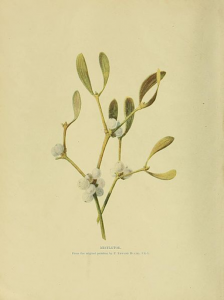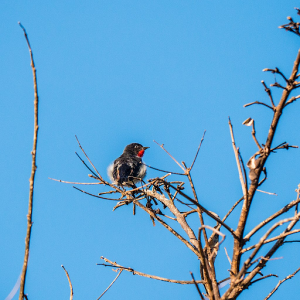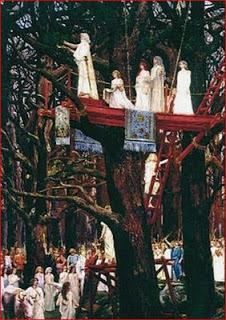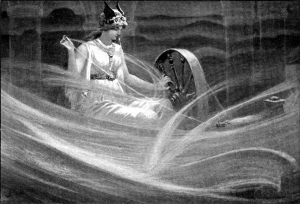Mystical Mistletoe
 A Riddle
A Riddle
I lived my life between the worlds
Neither earth nor sky would call me child
The birds were my companions
The wind and rain my mentors
Daily I grew in power and strength
Till snatched out of time by the trickster
[Answer: Mistletoe]
This winter is calling for hunkering down, and a bit of a deep dive. We may not be able to travel physically right now, but we can always visit different times and places through reading. At this time of year I found myself curious about one mirthful plant in particular. Mistletoe. You’ve probably heard of the tradition of kissing under the mistletoe but do you know where the tradition comes from? Let’s take a look at this mystical plant throughout culture, history, and medicine. 
Imagine being alive in the time of the Ancient Druids, around the 1st century CE. It’s cold. It’s grey. The leaves have fallen off of most trees, including the all mighty Oak. And then, there, you see it! An otherworldly bundle of everyone’s favorite parasite. Yes, you read correctly. The romantic holiday favorite is a parasite. Well, at least a partial parasite.
Parasitic Plant
It’s true! Mistletoe is a partially parasitic plant. Mistletoe relies on modified roots that serve as a conduit through which the parasite steals water and minerals from its host. Mistletoe doesn’t need sugar, proteins, or other nutrients from its host because it’s photosynthetic green leaves take care of that. The roots penetrate the tree bark, siphon off water and minerals that trees carry up their trunks to disperse its seeds on nearby trees. How do the seeds get there?
Get by With a Little Help From my (Feathered) Friends
Is it magic? Not… exactly. Mistletoe spreads its seeds with the help of some feathered friends. Many species of birds love to eat mistletoe, especially in the winter when other food sources become scarce. The berries of mistletoe are very sticky. Sometimes birds wipe their feet on tree bark to try to get rid of the berry’s tenacious residue. One bird that loves mistletoe berries is the mistletoe bird! And sometimes, well, the bird leaves a fly by dropping on a nearby tree. Fun fact: The word “Mistletoe” is derived from the Old English words, “mistel” (dung) and “tan” (twig). The plant is thought to be named after bird droppings on a branch. [source: https://www.dictionary.com/e/mistletoe/]
One bird that loves mistletoe berries is the mistletoe bird! And sometimes, well, the bird leaves a fly by dropping on a nearby tree. Fun fact: The word “Mistletoe” is derived from the Old English words, “mistel” (dung) and “tan” (twig). The plant is thought to be named after bird droppings on a branch. [source: https://www.dictionary.com/e/mistletoe/]
Don’t throw out your mistletoe just yet!
This treasured plant isn’t all take, it’s a giver too. Mistletoe can have a positive impact on biodiversity. Helping not only humans, but many plants and animals in its ecosystem as well. That’s because mistletoe is what is known as a keystone species. In any arrangement or community, the “keystone” is considered one of the most vital parts. A keystone species is an organism that helps hold the system together. Without its keystone species, ecosystems would look very different. Some ecosystems might not be able to adapt to environmental changes if their keystone species disappeared. That could spell the end of the ecosystem, or it could allow an invasive species to take over and dramatically shift the ecosystem in a new direction.[https://www.nationalgeographic.org/encyclopedia/keystone-species/]
Animals that eat mistletoe include deer, elk, squirrels, chipmunks, porcupines, robins, bluebirds, mourning doves and the butterfly genus Delias. It’s also a host plant to the oak tree loving Purple Hairstreak butterfly and helps other plants in its ecosystem, like Juniper, flourish.
Biology
Mistletoe is a general name for plants in the Mistletoe family (Viscaceae). Our Christmas mistletoe comes primarily from two species, Viscum album, which is the mistletoe of Europe, and Phoradendron leucarpum which is native to the US. Mistletoes have evergreen leaves and stems of the mistletoe appear to be jointed because of constrictions at the nodes. The plant breaks easily at these constrictions. Mistletoes can parasitize a variety of species, but they are especially common on oaks. [Source:http://www.employees.csbsju.edu/ssaupe/essays/mistletoe.htm]
Perhaps in part because of its unusual biology, mistletoe is a plant that fascinates throughout the ages. Let’s go a little deeper. Let’s get a little . . . mystical shall we?
Ancient Druids
Did you know the word ‘Druid’ is not Celtic but a conflation of the Greek word drus (oak tree or oak wood) and the Indo-European infinitive wid (‘to know’). Thus, a Druid is, metaphorically, ‘one who knows the oak’.  Oak trees have a special sanctity in Celtic tradition. [Source:http://www.astro.nu/2019/05/03/who-were-the-druids-the-mistletoe-and-the-secret-tradition/]. The ancient Druids believed mistletoe to be an indicator of great sacredness, especially when found on an oak tree, which was said to be a rare occurrence. According to Piny the Elder, Roman naturalist, the plant was used in both medicine and ritual. Mistletoe was used as a balm against epilepsy, ulcers, and poisons. Piny also notes that Winter Solstice was called “Alban Arthan” and according to Bardic Tradition, the Chief Druid would cut mistletoe from the oak. It was cut using a golden sickle on the sixth night of the new moon after the Winter Solstice. Mistletoe was also known as a symbol of fertility, and was hung over doorways as protection against thunder, lightning and other evils. Sky Gazing tip: For anyone interested, the Winter Solstice 2020 in the Northern Hemisphere will be at 5:02 AM Est on Monday, December 21. The sixth night of the new moon falls on January 19, 2021.
Oak trees have a special sanctity in Celtic tradition. [Source:http://www.astro.nu/2019/05/03/who-were-the-druids-the-mistletoe-and-the-secret-tradition/]. The ancient Druids believed mistletoe to be an indicator of great sacredness, especially when found on an oak tree, which was said to be a rare occurrence. According to Piny the Elder, Roman naturalist, the plant was used in both medicine and ritual. Mistletoe was used as a balm against epilepsy, ulcers, and poisons. Piny also notes that Winter Solstice was called “Alban Arthan” and according to Bardic Tradition, the Chief Druid would cut mistletoe from the oak. It was cut using a golden sickle on the sixth night of the new moon after the Winter Solstice. Mistletoe was also known as a symbol of fertility, and was hung over doorways as protection against thunder, lightning and other evils. Sky Gazing tip: For anyone interested, the Winter Solstice 2020 in the Northern Hemisphere will be at 5:02 AM Est on Monday, December 21. The sixth night of the new moon falls on January 19, 2021.
The Norse Myth of Balder/Loki/Frigga
Mistletoe is found in the myths and folklore of many cultures. It is perhaps most famous in the Norse Myth of Balder, his mother Frigg, and a Trickster named Loki. Once upon a time Balder had terrible premonitions of his own death. Each night, as he slept, the frightening vision returned. Balder’s nightmares became so bad, that he had to turn to his mother Frigg for help. Frigg is the goddess of Love and Beauty, as well as Home, Marriage and Motherhood. Fun fact: Fridays are named after her! Frigg of course stepped in to help her dearest and much beloved son, Balder. The goddess was said to request an oath from all beings in her wake, and all beings agreed: they would not harm Balder. Once receiving this sworn word, Balder was deemed invincible. The gods rejoiced and celebrated by testing Balder’s new found strength: throwing rocks, and shooting at him. Alas, no matter what method was tried, nothing could hurt him! Everyone grew in merriment except for one, the trickster Loki.  Loki was so displeased that he disguised himself as a peasant woman and slyly interrupted the festivities, asking Frigg, “Have all things sworn an oath to protect Balder?” Frigg smiled and responded to the old woman dismissively that yes, all except for the young mistletoe plant that she deemed too innocent to need swearing such an oath. Upon hearing this answer Loki in disguise fixed his gaze upon Hodr, Balder’s brother. Hodr was a blind God and he was sitting on the edge of the group’s circle. Loki approached Hodor and asked why he wasn’t participating in the fun. Hodr replied that he could not see the target and didn’t have a weapon. Loki quickly offered to help the blind God. “I’ll show you wear to aim, and here – use this twig! Shoot it at your brother and join in this revelry.” Hodr took the mistletoe from Loki and threw it at his brother. Everyone stood in awe as the mistletoe pierced Balder, bringing him down to his death. The gods wept bitterly. None more so than Frigg. In one ending of this myth Frigg is so destroyed with pain at the loss of her Balder that she is overcome with tears. Her outpouring of tears are reflected in the milky white berries of mistletoe. Frigg convinces every being to weep for Balder so that he may be restored to life. The Gods are moved by the outpouring of tears and agree to bring Balder back to life, with one condition: the mistletoe must promise that it will never again cause harm and henceforth only be used in acts of happiness. Overwhelmed with joy, Frigg repays this kindness with kisses for all as everyone embraces beneath the fated mistletoe plant. In this story we see mistletoe transformed from a symbol of death into one of peace and love. [Source: https://www.anbg.gov.au/mistletoe/balder-myth.html Source: The story of Balder is set out in Frazer’s monumental work The Golden Bough.]
Loki was so displeased that he disguised himself as a peasant woman and slyly interrupted the festivities, asking Frigg, “Have all things sworn an oath to protect Balder?” Frigg smiled and responded to the old woman dismissively that yes, all except for the young mistletoe plant that she deemed too innocent to need swearing such an oath. Upon hearing this answer Loki in disguise fixed his gaze upon Hodr, Balder’s brother. Hodr was a blind God and he was sitting on the edge of the group’s circle. Loki approached Hodor and asked why he wasn’t participating in the fun. Hodr replied that he could not see the target and didn’t have a weapon. Loki quickly offered to help the blind God. “I’ll show you wear to aim, and here – use this twig! Shoot it at your brother and join in this revelry.” Hodr took the mistletoe from Loki and threw it at his brother. Everyone stood in awe as the mistletoe pierced Balder, bringing him down to his death. The gods wept bitterly. None more so than Frigg. In one ending of this myth Frigg is so destroyed with pain at the loss of her Balder that she is overcome with tears. Her outpouring of tears are reflected in the milky white berries of mistletoe. Frigg convinces every being to weep for Balder so that he may be restored to life. The Gods are moved by the outpouring of tears and agree to bring Balder back to life, with one condition: the mistletoe must promise that it will never again cause harm and henceforth only be used in acts of happiness. Overwhelmed with joy, Frigg repays this kindness with kisses for all as everyone embraces beneath the fated mistletoe plant. In this story we see mistletoe transformed from a symbol of death into one of peace and love. [Source: https://www.anbg.gov.au/mistletoe/balder-myth.html Source: The story of Balder is set out in Frazer’s monumental work The Golden Bough.]
Medicine
In Folk Medicine mistletoe is known as “All Heal”. We learned from our journey with the Druids that mistletoe has long been used to cure a variety of ills. Is mistletoe used for healing purposes today?
Yes and no. Today, mistletoe is used medicinally, especially in Germany, to treat a variety of conditions including hypotension and cancer. The plants contain a variety of poisonous proteins (phoratoxins and viscotoxins) as well as cytotoxic glycoproteins (lectins). Studies have not conclusively demonstrated the efficacy of mistletoe, and because of its high toxicity, mistletoe tea or other preparations are most definitely not recommended for home remedy.[Saupe]
Mistletoe is now one of the most widely studied complementary therapies for cancer, with 1,000 in vitro studies showing that mistletoe or its main constituents have anticancer activity. In parts of Europe, extracts of mistletoe sold under brand names such as Iscador, Helixor and Eurixor are among the most prescribed therapies for cancer. But an investigation by Edzard Ernst, former professor of complementary medicine at the University of Exeter, showed that the findings of studies into mistletoe’s medicinal properties are inconsistent, with some reports showing it has considerable potential for harm. [https://www.pharmaceutical-journal.com/opinion/blogs/mistletoe-in-folklore-and-in-medicine/11091799.blog?firstPass=false]
Decoration
Okay, but what about decor? I don’t recall seeing mistletoe in church growing up. Mistletoe is still used as a festive holiday decoration, but not in many churches! This is probably due to its ties to pagan rituals of old and new. Mistletoe became popular first within British traditions.  According to Margaret Baker, the kissing tradition appears to have caught on among servants in England before catching on in popularity, spreading to the middle classes and America.
According to Margaret Baker, the kissing tradition appears to have caught on among servants in England before catching on in popularity, spreading to the middle classes and America.
In Nature
A plant this beguiling deserves a look in the wild. Alex, Adult Education Manager, informed me that there is a bunch of mistletoe right here in Norfolk Botanical Garden! As I walked through the paths of NBG where else would I find myself but the Enchanted Forest? It was here on these quiet unpaved paths that I could really imagine what it must have been like to discover this plant in the mystical days of yore.There’s something special about oak trees isn’t there? Symbols of strength and sturdiness standing tall. And mistletoe, well that would just be the berry on top now wouldn’t it? If you’ve made it this far, thanks for reading. And – if you are looking for a sweet moment to share with someone special, might I recommend the end of Rose Garden Bridge? Look up!
All images sourced from Wikimedia Commons.





